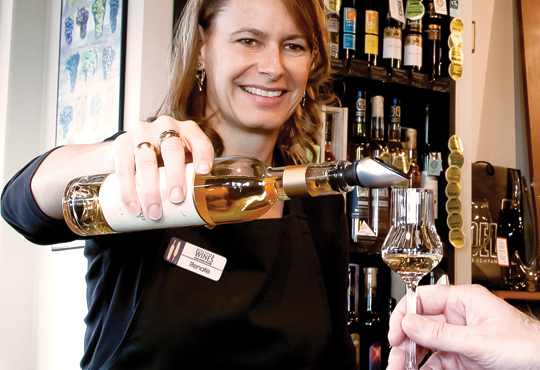On a snowy winter morning, a small stream of luscious deep red wine flows into Jim Perwal’s glass as he stands at the bar. Peering out the expansive window overlooking Okanagan Lake, he and his wife Sylvie marvel at how the grey clouds have parted to reveal a shimmering oval sphere of light smack in the middle of the water. They won’t forget this day. It’s their 25th wedding anniversary and they’re celebrating with a trip through four Okanagan wineries. Quails’ Gate is their first stop, and the Old Vines Foch slips down with ease despite the early hour.
The couple travel here regularly from their home in Grand Forks, but this is the first time they’ve taken in arguably the region’s most popular pastime—wine touring. Plans for their silver anniversary took place after the provincial government instituted its new drinking penalties and it certainly gave them pause. “I was kind of worried about it, so we picked a wine tour company to take us around,” Jim says. “Normally we would have driven ourselves and I wouldn’t have had anything to drink. I can have half a glass of wine and I know I’m done,” Sylvie laughs. “So we went with the tour. We both wanted to enjoy this.” It’s the kind of situation that means business is ramping up during the usual slow season for Patti Ogden-Grady, president of Okanagan Wine Country Tours. “Every year we’re busier in the slow season, but this new law has changed things. People don’t want to drive.” Jim, who drives for a living, says he’s already seeing improvements on the road. “The drunk drivers on the road have really declined since this went in. I know people are saying government should take another look at the legislation, but I say don’t do that. It’s working.” That’s especially good news in areas where tastings can be had a hop, skip and jump from each other. In Naramata, West Kelowna and the Golden Mile in Oliver, there are 10-kilometre stretches of road dotted with wineries. A sip here, a sip there and before you know it even someone with a larger frame could find themselves in trouble. The laws around tastings limit wineries to serving no more than one ounce, but rumours circulate that some are more, shall we say “generous” with their samples, and that only compounds things. And while there are spittoons on every bar, North Americans are notoriously averse to using them. Leave that to the professionals. “I was looking at the basin—and I’m not sure I’d even know how to do that,” laughs Sylvie. The change in the law is doing more than altering who is on the roads. It’s also altering people’s purchasing habits—even in a higher-end restaurant like Hanna’s Lounge and Grill where having an extensive wine cellar makes up part of the cache. “Over all in the dining room most liquor sales are down 10 per cent, but wine sales are down 40 per cent,” says general manager Andrew Neville, noting even their usually successful two-for-one dining program flopped. “What we’re seeing is people are having a glass instead of a half-litre or a half-litre instead of ordering a bottle. Basically what we’re seeing is the more responsible drinkers cutting back. In the pub (Rose’s) downstairs, wine isn’t down as much.” The trickledown effect is obvious—when Andrew shows up for work in the morning the wineries that do direct delivery know to leave only half as many crates. The call for orders simply isn’t there. Whether in the tasting room or the dining room, the challenge now is how to bring those sales up—and restore consumer confidence in a region that has spent more than two decades establishing itself as a focal point for wine tourism. Some worry that they won’t really know what hit them until May with the arrival of the Spring Wine Festival. There are already ominous signs. At Discover Wines in Kelowna, home to more than 500 VQA wines, owner Tracy Gray says she’s received a few emails from tourists saying they’re making other plans. “I’ve had a few emails from people from out of province that I’ve passed on to people in the industry. They say they’re not coming here next year and they’re going to do their wine touring somewhere else. They say it’s too expensive in BC and the rules are making it too difficult so they’re going to Washington and Oregon this year. I think this could actually be hard on tourism.” Tracy says it’s all a bit difficult in a province that already has a reputation for having the strictest liquor laws in the country. It was only with Expo ’86 that pubs and bars opened on Sundays, and even today wine and beer still can’t be purchased in grocery stores. The result is you can almost hear the crystal shatter at the mention of even tougher laws. Many winery business insiders have little appetite for BC following suit with other countries like Germany (.03 if in an accident) or Norway, Poland and Sweden (.02). Wine growing countries like France and Italy already have a .05 limit. “The more restrictive this province becomes, the more it will impact tourism,” she says. “My question is: is this law really targeting the right people?” And that’s a fair question. As it stands, any adult who weighs less than 130-pounds is likely to land in the warning range with only one drink. That means zero tolerance for many women, very few men. And yet ICBC stats show males account for 77 per cent of all impaired drivers. And drivers between the ages of 16 and 25 make up the highest number of impaired drivers, yet the current rules are tied to time-on-the-road, not age. The other issue for those in the wine business is countering both the responsibility and anxiety factors. Heading into the recent Christmas season, Tracy says sales were up overall, but she did witness a drop in the number of bottles ordered for business receptions. That sent a signal that few businesses were offering taxi rides home from parties—a legal bell weather if there ever was one. Meanwhile a spike in the handy single-serving breathalyser made it the stocking stuffer of the season. Nancy Holmes, who lost both her aunt and uncle to a drunk driver, picked up a handful for her sons who are all in their 20s. “I know for me, I’m not drinking when I’m out any more. Every Tuesday night I used to go to the bar for a trivia night and have a beer or two. Now I have club soda and OJ, I just stopped drinking all together. I’m not a very big person and my car is my life.” Of course life looks a whole lot different in urban areas where people can walk from bar to restaurant to nightclub and then grab a cab. In Vancouver, 24-hour transportation is virtually instant and hotels like the chic Moda Hotel near the Orpheum fired off a “Take the Elevator Home” promotion acknowledging that some patrons at its Uva Wine Bar may want to simply “tumble or stumble” into a room after drinking a $108 bottle of Osoyoos Le Grand rather than risking the road. Fortunately for everyone there are rules on the books that restaurants have seldom used, rules that now seem to have been designed with foresight. No wonder. Renowned BC vintner Harry McWatters was behind the seldom used regulation that allows diners to take home their open bottle of wine, provided the server re-corks it. “We didn’t really romance that aspect of the law before, probably because it wasn’t an issue, and it’s amazing how many people don’t know about this,” Andrew says. “We took the wording right from the Liquor Control Board handbook and included it in our print advertising. And we’ve put it on our menus too. We’ve even bought wine bags so people have proper bags so they can take their wine home, rather than using a brown paper bag.” Tourists can expect to hear this conversation more often as restaurateurs grapple with their new world. Up the road at the Sunset Organic Bistro at Summerhill Pyramid Winery, a light lunch came with an offer to buy a bottle of wine at the same price as in the winery. Simply cork the remainder and stay safe on the road. So far, the idea hasn’t quite caught on, but Hanna’s owner Rose Sexsmith says the quickly imposed new regulations caught many off guard and it will require change—whether education on the part of consumers or improvements to transportation options in less urban areas. “What I keep telling myself is ‘crisis or opportunity’ and what I hope to see happen is we are given options on how people are going to go out and then get home safe and sound.” Back in West Kelowna, Old Vines Restaurant at Quails’ Gate has launched a new shuttle service that picks guests up from their home and drives them back. It all comes neatly packaged with the fee ending up on your restaurant bill. By working in partnership with an already existing touring company, they were able to avoid the issue of having to obtain a license—a challenging endeavour as the rules stand right now. “We really want our guests to feel at ease and know they can have a couple of glasses of wine and not worry about it,” says Kristin Peturson-Laprise. Other wineries are coping with the new rules in a different way. At Little Straw, a small boutique winery a few kilometres away, Tina Slamka says their restaurant always maintains a two-glass limit for all guests. And at the tasting bar, the provincial regulations are now prominently posted. “We’re always very conscious of drinking and driving,” says Tina, who works the winery and vineyard along with other family members ranging in age from 14 to 21. “I think we need to set an example with our kids, so we set that bar pretty high.” At Quails’ Gate, server Peter Stefan is polishing up some glasses for the next group of visitors. He says the youngsters have it right. The responsible ones are taking the new laws in stride—no doubt because they started their driving career with a hefty dose of zero tolerance. And he believes the older crowd is taking this to heart. When he gets together with his eight or so wine club buddies, they used to open up five bottles. Now they’re down to four. “I even picked up some of those self-test breathalysers and we all tried it out. Everyone was fine. We thought we would be, but it was good to know for sure. It’s more the uncertainty.” Peter’s hope is that this most recent change will serve to bring more wine lovers to the understanding that appreciation is more about taste and experiencing something unique than it is about consuming. As British Columbians get used to the new laws, the question remains whether this particular ounce of prevention is worth a pound of cure. —Karin Wilson Photo by Douglas Farrow




0 Comments